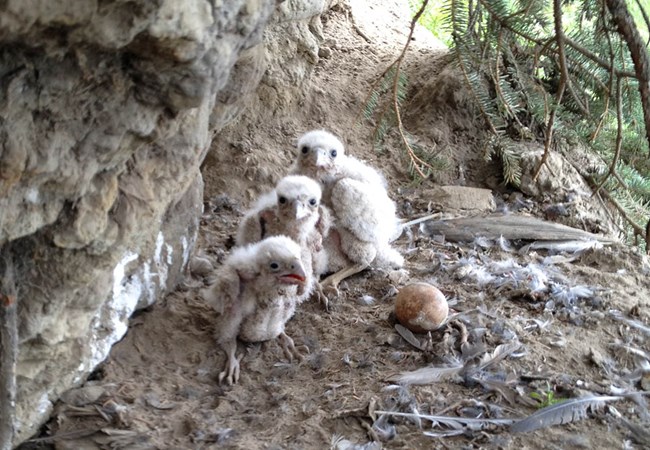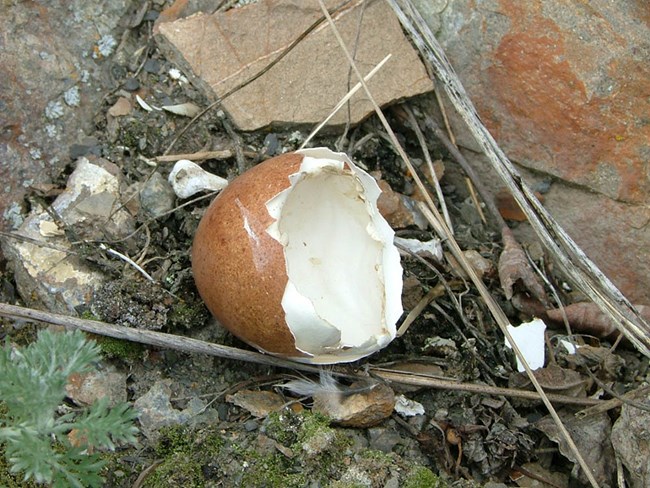Last updated: November 3, 2022
Article
What genetics can tell us about Peregrine Falcon recovery

NPS/Melanie Flamme
Genetic diversity of Peregrine Falcon (Falco peregrinus) populations nesting in Alaska was compared before, during, and after declines caused from bioaccumulation of dichlorodiphenyltrichloroethane (DDT). [DDT endangered a number of bird populations because DDT had the effect of weakening their egg shells, meaning that birds couldn't successfully reproduce.] We used microsatellite and mitochondrial (mtDNA) data to assess impacts of the severe mid-20th century population crash that extirpated the falcons from parts of North America and Europe and reduced some populations by over 75%. After the crash, some locations used captive-bred falcons to augment diminished populations but falcons in Alaska recovered naturally without introductions. Genetic diversity measures in naturally recovered peregrine populations nesting along the Colville (Arctic) and upper Yukon (Interior) Rivers were compared across three time periods around the crash: pre-decline (1899-1968), decline (1985) and post-decline (2001-2009). Metrics included estimates of heterozygosity, mean number of alleles, allelic richness, haplotype and nucleotide diversity, private alleles and private haplotypes (those found only in focal population that may reveal local adaptation), effective population size (number of breeding individuals in the population), inbreeding coefficient (consanguineous breeding), χ2 (differences in the temporal distribution of alleles and haplotypes), Hardy-Weinberg equilibrium (influence of evolutionary forces including genetic drift, open population, mutation, assortative mating and/or natural selection) and linkage disequilibrium (statical linkage between alleles).

The decline was of short duration (~10-15 years) and samples sizes were low for the decline period but represented 17.2% (Arctic) and 18.5% (Interior) of pairs detected in monitored breeding populations. Differences among time periods and populations were observed at various metrics. Biases in diversity increased post-decline for Arctic (as expected for recovery) but decreased post-decline for Interior. This may be due to differences in population demography and history. Interannual variation in the proportion of pairs with young was ~2x greater in Interior than Arctic. Abundance stabilized in the mid-1990s within Arctic but not until the early 2010s in Interior. This may indicate that Arctic may be closer to achieving equilibrium than Interior. The Arctic reached population stability within 10-15 years after 1968, following only a few generations demonstrating that genetic variation can change rapidly in response to microevolutionary and demographic processes.
We found that the natural recovery in both populations after the crash resulted from recruitment from within and immigration. However, data among time periods in Arctic suggest variance in productivity and reduced effective population size, indicative of inbreeding. For Interior, differences in diversity metrics pre- and post-decline suggest recovery involving only a few falcons. Further, increases in biases of genetic diversity metrics, influx of new alleles/haplotypes, population growth, and variance of effective population size in post-decline suggest recovery was enhanced by natural immigration. Peregrine falcons from both regions were likely dispersing across the landscape maintaining gene flow and connectivity that dampened the effects of genetic drift by increasing the number of breeders and retaining genetic diversity throughout the decline.
The DDT-induced decline influenced genetic diversity in naturally recovered Peregrine falcons (Falco peregrinus) nesting within the Alaska Arctic and eastern interior
Abstract
We assessed the influence of the severe mid-20th century population decline on genetic diversity in non-augmented Peregrine Falcon Falco peregrinus populations nesting within the Alaska Arctic and eastern Interior. Microsatellite and mitochondrial DNA (mtDNA) data were analysed for Peregrine Falcons sampled from three periods: pre-decline, decline and post-decline. The influence of the decline on genetic diversity differed between the two locales. The Alaska Arctic was characterized by shifts in mtDNA haplotype frequencies, increased inbreeding coefficient, reduction in effective population size and increase in private haplotypes, and a signature of post-decline population growth was detected; by contrast, the eastern Interior showed a reduction in haplotype diversity and no differences in allelic or haplotypic frequencies between pre- and post-decline periods, though pre-decline birds clustered away from the other two periods and allelic frequency differences were observed between decline and post-decline periods. Patterns in genetic diversity suggest populations recovered through recruitment from within and immigration.
Sonsthagen, S. A., T. Swem, S. Ambrose, M. J. Flamme, C. M. White, G. K. Sage, and S. L. Talbot. 2022. The DDT-induced decline influenced genetic diversity in naturally recovered Peregrine falcons (Falco peregrinus) nesting within the Alaska Arctic and eastern interior. IBIS: e13095.
